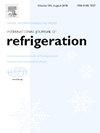利用氪冷却粒子探测器加速器的喷射器支撑循环的热设计
IF 3.5
2区 工程技术
Q1 ENGINEERING, MECHANICAL
International Journal of Refrigeration-revue Internationale Du Froid
Pub Date : 2025-06-26
DOI:10.1016/j.ijrefrig.2025.06.030
引用次数: 0
摘要
根据高亮度计划(HL-LHC),大型强子对撞机将升级,以进一步扩展物理发现(2033-2034)。随着光度的增加,用于探测这些粒子的硅传感器上的辐射损伤也随之增加,这些辐射损伤必须防止热失控,否则传感器将达到电击穿。未来的升级将要求冷却系统的温度水平在-60至-80°C之间,这是目前二氧化碳冷却技术(2PACL)无法实现的。根据前人的研究,选择稀有气体氪作为未来探测器热管理的工作介质。为了满足新一代粒子加速器的要求,提出了一种新的喷射器支撑冷却系统。在这项工作中,从探测器开始进行了创新喷射器循环的热设计。为了保证探测器的最佳工作状态,首先设计了半被动探测器回路。液体氪由喷射器提供给探测器,与工作温度无关,保持恒定的压力提升,流量变化不超过设计值的4.3%。由压力、密度和流量表示的边界条件将作为可调几何喷射器设计的输入。为了验证沿探测器的热稳定性,还讨论了处理设定值变化和冷却功率突然变化的控制策略的开发。在热负荷波动的非设计情况下,蒸发温度在0.3 K以下出现偏移。本文章由计算机程序翻译,如有差异,请以英文原文为准。
Thermal design of an ejector-supported cycle using krypton for cooling of particle detector accelerators
According to the High-Luminosity plan (HL-LHC) the Large Hadron Collider will be upgraded to further extend physics discoveries (2033–2034). The increase of the luminosity is followed by an increase of the radiation damage on the silicon sensors used to detect those particles, which they must be preserved from the thermal runaway after which the sensors reach electrical breakdown. The future upgrade will require to the cooling system temperature levels ranging from -60 to -80 °C, currently unattainable by the CO2 cooling technology (2PACL). From a previous study the noble gas krypton was selected for the thermal management of future detectors as working medium. To meet the requirements of the new generation of particle accelerators, a new ejector-supported cooling system was proposed.
In this work, thermal design of the innovative ejector cycle was carried out starting from the detector. The semi-passive detector loop was first designed to ensure optimal working conditions of the detector. Liquid krypton is supplied to the detector by the ejector, maintaining a constant pressure lift independently of the operating temperature, with a flow variation not exceeding 4.3 % of the design value. The boundary conditions expressed by pressure, density and flow rates will serve as inputs for the design of the adjustable geometry ejector. To verify the thermal stability along the detectors, development of a control strategy to handle setpoint changes and sudden change in the cooling power is also addressed. The off-design case with fluctuating heat loads shows an offset in the evaporating temperature below 0.3 K.
求助全文
通过发布文献求助,成功后即可免费获取论文全文。
去求助
来源期刊
CiteScore
7.30
自引率
12.80%
发文量
363
审稿时长
3.7 months
期刊介绍:
The International Journal of Refrigeration is published for the International Institute of Refrigeration (IIR) by Elsevier. It is essential reading for all those wishing to keep abreast of research and industrial news in refrigeration, air conditioning and associated fields. This is particularly important in these times of rapid introduction of alternative refrigerants and the emergence of new technology. The journal has published special issues on alternative refrigerants and novel topics in the field of boiling, condensation, heat pumps, food refrigeration, carbon dioxide, ammonia, hydrocarbons, magnetic refrigeration at room temperature, sorptive cooling, phase change materials and slurries, ejector technology, compressors, and solar cooling.
As well as original research papers the International Journal of Refrigeration also includes review articles, papers presented at IIR conferences, short reports and letters describing preliminary results and experimental details, and letters to the Editor on recent areas of discussion and controversy. Other features include forthcoming events, conference reports and book reviews.
Papers are published in either English or French with the IIR news section in both languages.

 求助内容:
求助内容: 应助结果提醒方式:
应助结果提醒方式:


